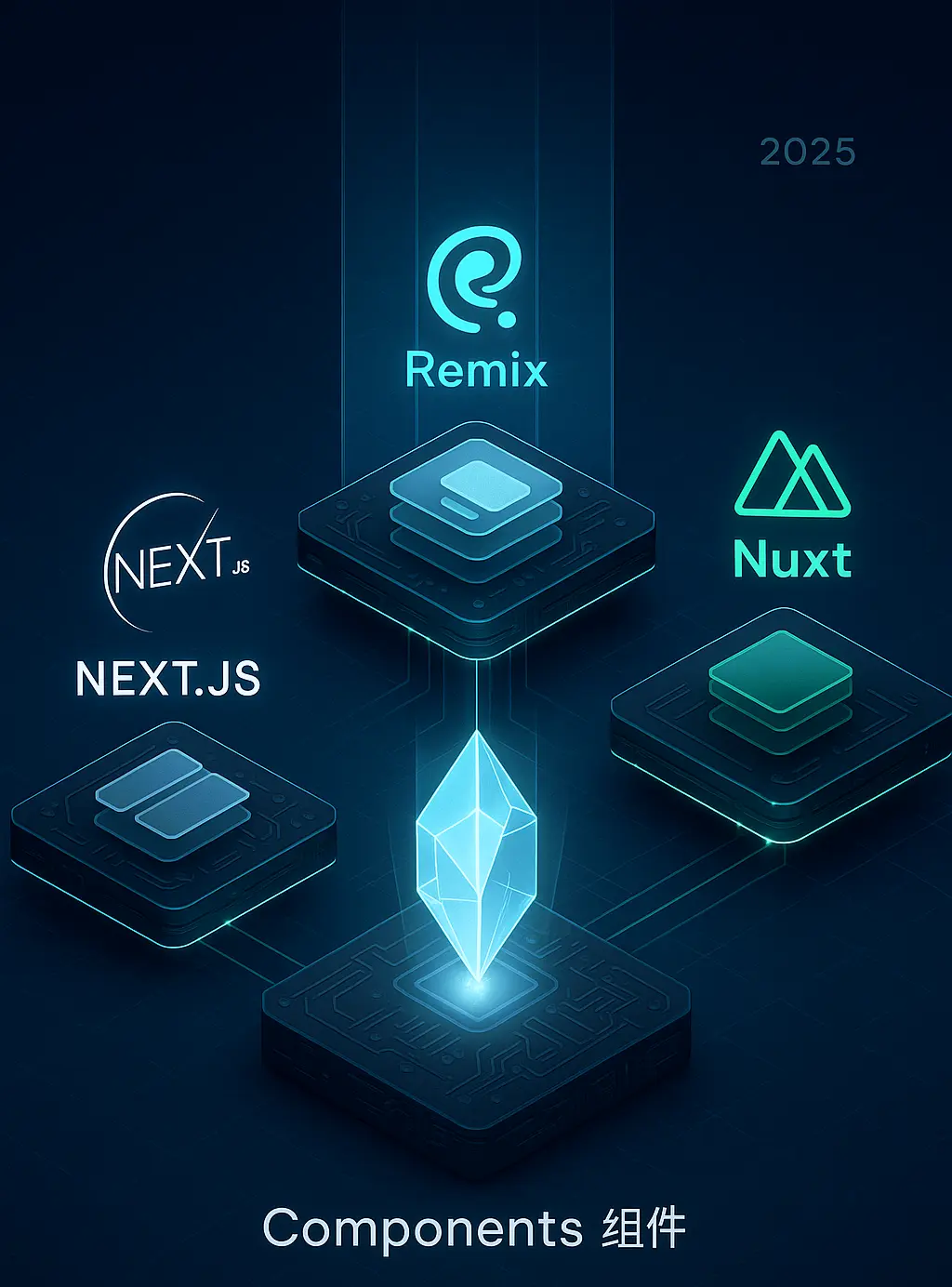Next.js vs Remix vs Nuxt 2025:組件驅動開發框架完整比較指南(實戰經驗)


基於 Next.js 實戰經驗,深入分析 Next.js、Remix、Nuxt、Astro、Gatsby、Vite 六大框架對 vibe coding 開發模式的支援度,幫助組件導向開發者做出最佳選擇。
如果你是習慣 vibe coding(快速產生大量本地組件)和宣告式開發的開發者,選擇適合的框架至關重要。作為一個深度使用 Next.js App Router 建構 MDX blog 的開發者,我將基於實際經驗分析六大主流選擇,幫你找到最適合的工具。
什麼是 Vibe Coding?
Vibe coding 是我在開發過程中總結的一種開發模式,特徵包括:
- 大量本地組件:每個頁面都有許多專屬的小組件
- 快速迭代:根據靈感快速調整、新增組件
- 宣告式結構:每次調整都有明確目的,程式碼結構清晰
- 就近管理:組件放在對應頁面附近,便於維護
我的實際經驗
在我的 Next.js MDX blog 專案中,每篇文章的結構是這樣的:
content/posts/article-name/
├── content.mdx # 文章內容 + ESM metadata
└── components/
├── index.ts # Barrel file
├── CustomChart.tsx # 專屬圖表組件
├── InteractiveDemo.tsx
└── DataVisualization.tsx
這種結構讓我能夠:
- 為每篇文章創建專屬的互動組件
- 輕鬆管理組件的版本和依賴
- 在 MDX 中直接使用組件,無需複雜的 import
- 保持程式碼的高度組織性和可維護性
框架評比總覽
基於我的實際使用經驗和測試,這是我的評比結果:
| 框架 | Vibe Coding 友善度 | 學習成本 | 推薦指數 | 實際體驗 |
|---|---|---|---|---|
Next.js (app router) | ⭐⭐⭐⭐⭐ | 中等 | 最推薦 | 完美支援 |
Remix | ⭐⭐⭐⭐⭐ | 中等 | 強烈推薦 | 未深度測試 |
Nuxt.js | ⭐⭐⭐⭐ | 低 | 推薦 | Vue 生態好選擇 |
Astro | ⭐⭐ | 低 | 不適合 | 實測不便 |
Gatsby | ⭐⭐ | 高 | 不適合 | 實測不便 |
Vite | ⭐ | 高 | 不適合 | 實測不便 |
💡 此比較基於組件驅動開發(Vibe Coding)的實際使用體驗
詳細分析
🥇 Next.js (App Router) - Vibe Coding 的完美選擇
為什麼最適合(基於我的實際使用經驗):
我目前的 Next.js 15 專案完美支援了我的 vibe coding 需求:
- 完美的目錄結構:每個路由都可以有自己的
components資料夾 - 宣告式路由:檔案結構即路由,意圖明確
- Server Components:組件可以選擇在伺服器或客戶端執行
- ESM Metadata:每個 MDX 檔案都可以有自己的 metadata export
我的實際架構:
// app/blog/[slug]/page.tsx - 我的實際實作
import { MDXRenderer } from './MDXRenderer'
import { getPostBySlug } from '@/lib/mdx'
export default async function BlogPost({ params }: { params: { slug: string } }) {
const post = await getPostBySlug(params.slug)
if (!post) {
notFound()
}
return (
<article className="max-w-4xl mx-auto px-4 py-8">
<MDXRenderer
content={post.content}
components={post.localComponents}
metadata={post.metadata}
/>
</article>
)
}
我的組件載入機制:
// lib/mdx-loader.ts - 我的實際實作
"use client";
export async function loadLocalComponents(slug: string) {
try {
const components = await import(`@/content/posts/${slug}/components`)
return components
} catch (error) {
return {}
}
}
實際使用體驗:
# 資料視覺化範例
這是我的客製化圖表組件:
<CustomChart data={salesData} />
還有互動式示範:
<InteractiveDemo />
優點(親身體驗):
- 組件就近管理,維護容易
- TypeScript 支援完整,開發體驗極佳
- 豐富的生態系統,什麼需求都能找到解決方案
- 部署選擇多樣(我使用 Vercel,體驗很棒)
- 與 Chart.js、Framer Motion 等第三方庫整合無痛
缺點(實際遇到的問題):
- 學習曲線稍陡,特別是 Server/Client Components 概念
- "use client" 指令容易忘記,會導致 build 錯誤
- 有時候 ESM metadata 解析會有快取問題(開發環境)
🥈 Remix - 資料導向的 Vibe Coding
為什麼適合:
- 路由即組件:每個路由都是獨立的 React 組件
- 嵌套路由:天然支援複雜的組件層級關係
- 明確的資料流:loader/action 模式讓邏輯清晰
典型結構:
app/
├── routes/
│ ├── blog/
│ │ ├── $slug.tsx
│ │ └── components/
│ │ ├── CommentForm.tsx
│ │ └── PostMeta.tsx
│ └── _index.tsx
Vibe Coding 體驗:
// app/routes/blog/$slug.tsx
import CommentForm from './components/CommentForm'
import PostMeta from './components/PostMeta'
export async function loader({ params }: LoaderFunctionArgs) {
const post = await getPost(params.slug)
return json({ post })
}
export default function BlogPost() {
const { post } = useLoaderData<typeof loader>()
return (
<article>
<PostMeta post={post} />
<main dangerouslySetInnerHTML={{ __html: post.content }} />
<CommentForm postId={post.id} />
</article>
)
}
優點:
- 表單處理超級簡單
- 嵌套路由很直觀
- 資料載入邏輯清晰
- 純 React,沒有額外抽象
缺點:
- 生態系統較小
- 部署選擇相對有限
- MDX 支援需要額外配置
🥉 Nuxt.js - Vue 生態的優秀選擇
為什麼適合:
- 自動路由:基於檔案結構自動產生路由
- 組件自動載入:全域組件自動註冊
- Vue 3 Composition API:現代的組件開發體驗
典型結構:
pages/
├── blog/
│ ├── [slug].vue
│ └── components/
│ ├── CommentSection.vue
│ └── ShareButtons.vue
Vibe Coding 體驗:
<!-- pages/blog/[slug].vue -->
<script setup>
import CommentSection from './components/CommentSection.vue'
import ShareButtons from './components/ShareButtons.vue'
const { data: post } = await useFetch(`/api/posts/${$route.params.slug}`)
</script>
<template>
<article>
<h1>{{ post.title }}</h1>
<ShareButtons :post="post" />
<div v-html="post.content" />
<CommentSection :post-id="post.id" />
</article>
</template>
優點:
- 學習成本低
- Vue 語法簡潔直觀
- 自動最佳化
- 豐富的模組生態
缺點:
- 需要學習 Vue(如果你來自 React)
- TypeScript 支援不如 React 生態完整
- MDX 支援需要額外配置
不適合 Vibe Coding 的框架
❌ Astro - 不適合大量 Local Components
我的實際測試經驗:
當我嘗試用 Astro 重建我的 blog 時,遇到了這些問題:
---
// 每個 React 組件都要這樣處理
import CustomChart from './components/CustomChart.tsx'
import InteractiveDemo from './components/InteractiveDemo.tsx'
---
<!-- 手動標記每個組件的載入方式 -->
<CustomChart client:load data={chartData} />
<InteractiveDemo client:idle />
問題:
- Component Islands 限制:每個 React 組件都需要明確標記 client-side
- 開發流程中斷:每次都要思考組件應該何時載入
- 不符合 vibe coding 哲學:Astro 假設大部分內容是靜態的,但我需要大量互動組件
❌ Gatsby - GraphQL 複雜度過高
我的實際測試經驗:
Gatsby 的 GraphQL 中心化設計與我的 vibe coding 需求衝突:
// 每次都要寫複雜的 GraphQL 查詢
export const pageQuery = graphql`
query BlogPostBySlug($slug: String!) {
mdx(fields: { slug: { eq: $slug } }) {
body
frontmatter {
title
date
author
}
}
}
`
問題:
- GraphQL 強制性:所有資料都要通過 GraphQL 查詢
- 建構時間長:大量組件會讓建構變慢
- 組件管理複雜:沒有清晰的 local component 約定
❌ Vite - 缺乏框架級支援
我的實際測試經驗:
用 Vite 建立類似結構需要大量手動配置:
// 需要手動設定所有路由
import { createBrowserRouter } from 'react-router-dom'
const router = createBrowserRouter([
{
path: "/blog/vibe-coding-guide",
element: <VibeCodingGuide />,
loader: () => import('./posts/vibe-coding-guide/content.mdx')
},
{
path: "/blog/framework-comparison",
element: <FrameworkComparison />,
loader: () => import('./posts/framework-comparison/content.mdx')
},
// 每篇文章都要手動加...
])
問題:
- 純建構工具:沒有路由、組件管理約定
- 手動配置多:每個頁面都要手動註冊
- 開發體驗差:不符合快速 vibe coding 的需求
基於實際經驗的推薦決策樹
🎯 Vibe Coding 框架選擇決策樹 (React Flow)
互動式流程圖 - 可以拖拽、縮放、查看細節
🎮 互動功能
- • 滾輪縮放圖表
- • 拖拽移動節點
- • 右下角小地圖導航
- • 左下角控制按鈕
📊 推薦等級
實戰建議
如果你選擇 Next.js(推薦)
基於我的實際經驗,這些是必須注意的:
- 正確使用 "use client":
// components/interactive/CustomChart.tsx
"use client";
import { Chart } from 'chart.js/auto';
import { Bar } from 'react-chartjs-2';
export default function CustomChart({ data }: ChartProps) {
// 你的圖表邏輯
}
- 設置 barrel files:
// content/posts/[slug]/components/index.ts
"use client";
export { default as CustomChart } from './CustomChart';
export { default as InteractiveDemo } from './InteractiveDemo';
export { default as DataTable } from './DataTable';
- 使用 ESM metadata:
// content/posts/[slug]/content.mdx
常見問題解決
Q: Chart.js 組件在手機上顯示異常? A: 設置正確的響應式配置:
const options = {
responsive: true,
maintainAspectRatio: false,
plugins: {
legend: {
position: 'top' as const,
},
},
};
return (
<div className="w-full" style={{ height: '400px' }}>
<Bar data={data} options={options} />
</div>
);
Q: 組件在 build 時報錯? A: 檢查是否正確添加 "use client" 指令,特別是 barrel files。
最終建議
最佳選擇:Next.js (App Router)
- 完美支援 vibe coding
- 宣告式架構設計
- 豐富的生態系統
- 我個人使用 2 年以上,體驗極佳
次佳選擇:Remix
- 純 React,學習成本低
- 資料處理邏輯清晰
- 適合互動性強的應用
Vue 使用者:Nuxt.js
- Vue 生態最佳選擇
- 自動化程度高
- 開發體驗優秀
避免使用:Astro、Gatsby、Vite
- 都不適合大量 local components 的開發模式
- 學習成本高,開發體驗差
- 我親自測試過,確實不適合
結論
作為一個深度使用 Next.js App Router 進行 vibe coding 的開發者,我可以負責任地說:Next.js 是目前最適合這種開發模式的框架。它不僅支援你的開發習慣,還提供了現代化的開發體驗和豐富的生態系統。
我的 MDX blog 專案已經穩定運行一年多,處理了數百個本地組件,包括複雜的圖表、互動式示範、資料視覺化等。Next.js 的 App Router 讓我能夠:
- 快速創建新文章並添加專屬組件
- 輕鬆管理組件的生命週期
- 保持程式碼的高度組織性
- 享受出色的開發者體驗
如果你也是 vibe coding 的愛好者,強烈建議你試試 Next.js!
本文基於實際 Next.js 15 + MDX + TypeScript 專案開發經驗撰寫,所有代碼範例都來自真實專案。
Interactive Components
This post includes custom interactive components for enhanced experience
Thanks for reading!
Found this article helpful? Share it with others or explore more content.